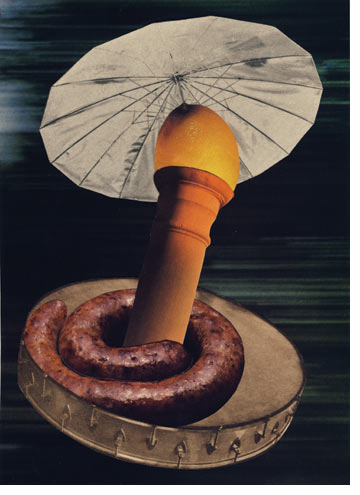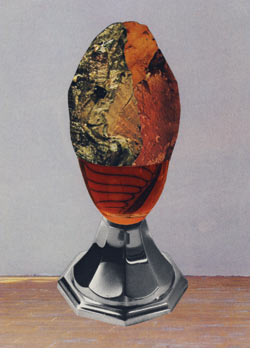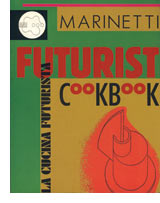| |
Meatpaper five
Dining for the Brave
Italian
Futurists take to the kitchen. Hide the animals and the power
tools.
by Laurie Loftus
illustrations by Cy de Groat
SEPTEMBER, 2008
 SEARCHING
HIGH AND LOW in my kitchen, trying to come up with
dinner, I found some beef tenderloin, an old 70-watt light
bulb, some shaved ice, and my flute. This presented me with
a quandary, as the recipe I was considering called for a
trumpet. I’m a fairly
confident cook, and I’ve been known to tinker with a
recipe or two, so I considered some substitutions. Other valved
brass instruments — a cornet, say, or a flügelhorn — I
would substitute for the trumpet without pause. I might even
consider judicious use of the bugle. But in the end, I decided
that crossing over from brass to woodwinds was too risky, and
resolved to try the dish called “Raw Meat Torn from Trumpet
Blasts” the next time my marching band friends stopped
by. SEARCHING
HIGH AND LOW in my kitchen, trying to come up with
dinner, I found some beef tenderloin, an old 70-watt light
bulb, some shaved ice, and my flute. This presented me with
a quandary, as the recipe I was considering called for a
trumpet. I’m a fairly
confident cook, and I’ve been known to tinker with a
recipe or two, so I considered some substitutions. Other valved
brass instruments — a cornet, say, or a flügelhorn — I
would substitute for the trumpet without pause. I might even
consider judicious use of the bugle. But in the end, I decided
that crossing over from brass to woodwinds was too risky, and
resolved to try the dish called “Raw Meat Torn from Trumpet
Blasts” the next time my marching band friends stopped
by.
All this thinking was making my stomach
growl, so I returned to my source for more options. Flipping
through The Futurist Cookbook, I began to suspect I was getting
no closer to dinner. In the trumpet recipe, for example,
the instructions were clear enough, but was I truly meant
to pass an electric current through my beef, marinate it
in a mixture of rum, cognac, and white vermouth, and serve
it on a bed of red pepper, black pepper, and snow? And, apart
from my difficulties in the kitchen, what of the challenges
awaiting me once I finally sat down to eat? In the spirit
of audience participation (or reader-as-author, or whatever
you call your favorite postmodern interpretive trip), my
meal would be complete only when consumed as directed: “Each
mouthful is to be chewed carefully for one minute, and each
mouthful is divided from the next by vehement blasts on the
trumpet blown by the eater himself.”
Enter meat. Electrified meat. Meat
imbued with perfume. Meat infused with steel.
Call me faint of
heart, but I shuddered to think of the collateral damage in
the wake of these staccato toots of pre-chewed carpaccio.
Upon
further inspection, this “cookbook” offered
few options that seemed more palatable, or practical, even
for more festive occasions. As enthusiastic as some of my friends
are about their meat, I wondered how they might react when
presented with “The Excited Pig:” “A whole
salami, skinned, is served upright on a dish containing some
very hot black coffee mixed with a good deal of eau de Cologne.”
Maybe
it was foolhardy of me to seek my next meal in a book with
Manifesto in its title.
The Manifesto of Futurist Cookery (The
Futurist Cookbook) was published in 1932 by Filippo Tommaso
Marinetti, Italian Futurism’s
founding father and front man, as a gastronomic coda to a cultural
movement that had, for largely political reasons, surged and
receded over the previous few decades. Marinetti and some like-minded
young painters and poets made their mark with the original
1909 Futurist Manifesto, a bombastic screed against nothing
less than 400 years of Italian history and its entire cultural
and social infrastructure — schools, churches, museums,
the lot.
The 1909 manifesto would form the template,
in spirit (“Don’t
trust anyone over 30”) if not in substance, of just about
every avant-garde/punk movement to follow. Take a bilious contempt
for middle class conventions and sensibilities, add a little
leftist populism for good measure, and bind it all with a love
of machines, militarism, and masculinity. “We declare
that the splendor of the world has been enriched by a new beauty:
the beauty of speed. ... We want to sing the man at the wheel.
... A roaring motor car which seems to run on machine-gun fire
is more beautiful than the Victory of the Samothrace.” Their
aesthetic will be familiar to fans of French Symbolism, Godard,
Brecht, and Johnny Rotten: “The essential elements of
our poetry will be courage, audacity and revolt. ... Poetry
must be a violent assault on the forces of the unknown. ...
Beauty exists only in struggle. There is no masterpiece that
has not an aggressive character.”
Despite their Clockwork
Orange rhetorical posturing, Marinetti and his droogies seemed
to be motivated by a heartfelt desire to pull their beloved
country from what they saw as the quicksand-like suck of its
classical past. Since this is Italy, it should come as no surprise
that such an appeal to the “sympathizers
of the New Italy” would reach into the country’s
most profound expression of national identity: food culture.
Their first order of business in The
Manifesto of Futurist Cookery: Go for Italy’s jugular.
Get its people to put down their pasta.
In a diatribe that
would thrill today’s anti-carbohydrate
fundamentalists, the Futurists launched an all-out assault
on the mangimaccheroni. While it is deemed “patriotically
acceptable” to substitute other starches, such as rice,
pasta is proscribed. Pasta eaters, they claimed, “forget
the lofty dynamic obligations of the race and the searing speed
and most violent contradictory forces that constitute the agonizing
rush of modern life.” In a delightful and peculiarly
Italian moment, Marinetti has to admit that pasta is delicious,
but he calls on progressive Italians to resist the lotus-like
lure of pasta, “a passéist food because it makes
people heavy, brutish … skeptical, slow, pessimistic.”
Pasta
represents individual regression and collective de-evolution:
Eating it demonstrates a failure to exert impulse control.
It is “a piggish enjoyment,” “short-lived
bliss,” “a debased and suburban form of pleasure.” Just
as the soothing pastoral scenes of realist painting are seen
to encourage a passive contemplation of life’s surface
pleasures, pasta eating is viewed by the Futurists as an anodyne
for middle-class malaise, the pasta eater attempting to fill
the gaping “black hole” of modern existential angst
and melancholy. “He may delude himself, but nothing can
fill it. Only a Futurist meal can lift his spirits.” To
marry a catch phrase from Italy’s favorite Marxist son,
Antonio Gramsci, with the Futurist cookbook banner: Pessimism
of the intellect, optimism at the table.
 Enter meat. Electrified
meat. Meat imbued with perfume. Meat infused with steel. Animals
served inside, beside, and on top of other animals. And (with
apologies to the Sex Pistols) never mind the Venus de Milo,
here’s the Sculpted Meat: Enter meat. Electrified
meat. Meat imbued with perfume. Meat infused with steel. Animals
served inside, beside, and on top of other animals. And (with
apologies to the Sex Pistols) never mind the Venus de Milo,
here’s the Sculpted Meat:
“Sculpted Meat” (a synthetic
interpretation of the orchards, gardens, and pastures of
Italy) is composed of a large cylindrical rissole of minced
veal stuffed with eleven different kinds of cooked vegetables.
This cylinder, standing upright in the middle of the plate,
is crowned by a layer of honey and supported at the base
by a ring of sausages resting on three golden spheres of
chicken meat. A marvel of balance.
If pasta is anti-virile,
meat represents the ability to grab modern life by the coglioni.
For the Futurists, the body is the machine of industry; its
engine, the brain. Its liveliness and energy are essential
to progress. “The great consumers
of pasta have slow and pacific characters, while meat eaters
are quick and aggressive.”
“The stomach,” says Marinetti, “expands
at the expense of the brain.” To eat meat is to ingest
energy in its most immediate form. Meat stokes the fire that
forges the new national identity. Meat increases individual
virility, which leads to national superiority. Meat confers
power. Power is sexy. Transitively, with all due apologies
to vegetarians: Meat is molto sexy.
But Futurist meat is
hardly caveman fare; meat is a food to be manipulated as
an artistic material, in a kitchen far from the homey hearth
of nonna and closer to the mad scientist’s
laboratory or the metalsmith’s foundry. “We speak
very precisely of the need to make use of electricity and of
all the machines that can improve the work of cooks.” Concocting
meals of meats surrounded by foams, vapors, oils, and smoke,
the Futurists predict and predate the wit, whimsy, and sensory
acumen of molecular gastronomists by 50 years. They bring the
sights, sounds, and smells of the city onto the plate, as if
the animals had been pulled, dusted in soot from urban streets
choked with Fiat exhaust and factory fumes. As if this were
a good thing.
For all their avowed interest in powering
the modern Italian body, the Futurist diet seems richer in
irony than iron. The symbolic value of their (literally)
tongue-in-cheek meat dishes could, I suppose, be understood
as an ongoing commentary on the dominance of technology over
nature, but it also mocks such an earnest academic interpretation,
as well as the dogma surrounding Italians’ cooking
and eating. For all their bombast and grandiloquence, what
the Futurists really seem to champion is a kind of culinary
absurdity that finds its counterpoint in a more kitchen-worthy
Italian classic, The Silver Spoon, the 1,200-page tome widely
regarded as “Italy’s
Joy of Cooking,” whose frontispiece declares, in bold
type:
EATING IS A
SERIOUS MATTER
To the Futurists, cooking is an expression
of imagination as high as in any art form. Likewise, to eat
is to contemplate a three-dimensional artwork “whose
original harmony of form and colour feeds the eyes and
excites the imagination before it tempts the lips.” Calling
for some of their dishes to be served with swatches of
velvet, sandpaper, and silk, they do take the experience
of “pre-labial sensations” rather
seriously, but they advocate improvisation and play on the
traditional modalities.
With that in mind, I sipped the cocktail
I’d mixed while
browsing the cookbook and glanced around my kitchen again.
My eyes seized on that tenderloin and my flute. Clearly, my
old flute didn’t have the windpower to propel even the
tenderest of tenderloin into carpaccio. But if I could get
my hands on some pig intestines. ... Maybe it’s the cocktail
talking, but I’m thinking ... Fauré’s Pavane sausages with a side of raw silk? 
 ULTRAVIRILE ULTRAVIRILE
On a rectangular plate put some thin slices of calf’s
tongue, boiled and cut lengthwise. On top of these arrange
lengthwise along the axis of the plate two parallel rows of
spit-roasted prawns. Between these two rows place the body
of a lobster, previously boned and shelled, covered in green
zabaglione. At the tail of the lobster place three halves of
hard-boiled egg, cut lengthwise, so that the yellow rests on
the slices of tongue. The front part, however, is crowned with
six cockscombs laid out like sections of a circle, while completing
the garnish are two rows of little cylinders composed of a
little wheel of lemon, slices of grape and a slice of truffle
sprinkled with lobster coral.
VEAL FUSELAGE
Slices of veal attached to a fuselage composed of cooked chestnuts,
little onions and sausages. All sprinkled with powdered chocolate.
SIMULTANEITY
A cocktail (polibibita) of wine, vermouth and aquavit garnished
with fresh dates, stuffed with mascarpone and wrapped in
prosciutto and lettuce leaves. If the toothpick is put into
the glass, eyes of fat deposited by the ham will appear on
the surface of the liquid: In this case, the polibibita can
be called “This little piggy who makes eyes at you.”
Laurie
Loftus is a Bay Area-based fundraising consultant, freelance
copy editor and writer, aspiring silversmith, and recovering
academic (one day at a time). She will admit to playing her
flute badly on occasion, though she promises never to try
sausage extrusion for real.
This article originally appeared in
Meatpaper Issue Five.

|
|
